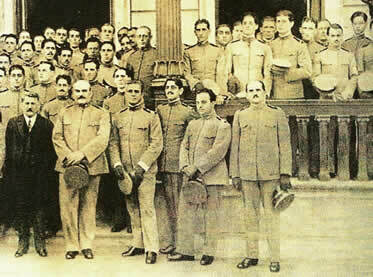THE Battle of Caporetto it took place between October and November 1917, in the context of World War I, pitting the Italian army against the military forces of the Austro-Hungarian and German Empires. The battles took place near the city of Kobarid (or Caporetto, for the Italians), in what is now Slovenia, the border region at the time between the Kingdom of Italy and the Austro-Hungarian Empire.
What is generally raised about the importance of the Battle of Caporetto is related to the fact that it has represented a great defeat for Italy and the use of innovations by the German army in tactics of war. On the other hand, the battle resulted in the rearrangement of the allies in the region, leading to a joint counteroffensive later on.
The German army's innovation was a tactic used against the Russians in Riga and applied more systematically after the Battle of Caporetto. It consisted of sudden and unprepared bombing actions as well as a nimble infiltration into the enemy-dominated area. This tactic was opposed to the one generally used in World War I, which consisted in the creation of feature films dams and rigid attack schemes (known as trench warfare), which left the troops almost properties. Troop mobilizations were supposed to take place at night until they reached the camouflaged positions.
The attacks began on October 24, 1917, with bombings initially carried out with gas to take advantage of the fragility of the masks used by Italian soldiers. The fighting continued until November 9, with German and Austro-Hungarian forces punishing Italian army troops, who stopped near the Piave river. The army of the Kingdom of Italy lost around 11,000 men, with 20,000 more injured and another 200,000 taken prisoner.
Do not stop now... There's more after the advertising ;)
The defeat in the battle of Caporetto had marked the Italians in such a way that the term came to have a connotation in the Italian language of defeat and disaster.
The resounding defeat led the allies, France and England, to support the Italians in the region to prevent further advances in the territory by the Germans and Austro-Hungarians.
A year later, in October 1918, the Italian army managed to reverse the situation with the help of French troops. They overcame the Piave River and managed to break through the enemy lines. The defeat imposed on the Austro-Hungarians was similar to that suffered by the Italians, with the difference that it contributed to the declaration of an armistice by the Austro-Hungarian Empire.
Caporetto's Battle inspired writer Ernest Hemingway to write his book goodbye to guns. Hemingway was in the battle, in support of the Italians, driving ambulances and collecting the wounded, which gave the book an autobiographical stamp.
By Tales Pinto
Master in History
Would you like to reference this text in a school or academic work? Look:
PINTO, Tales dos Santos. "Battle of Caporetto in World War I"; Brazil School. Available in: https://brasilescola.uol.com.br/guerras/batalha-caporetto-na-i-guerra-mundial.htm. Accessed on June 28, 2021.

